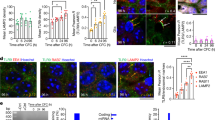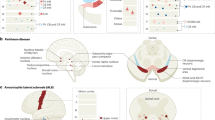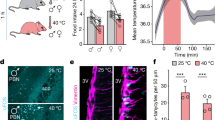Abstract
Brain-derived neurotrophic factor (BDNF) is known to play a critical role in the synaptic plasticity underlying the acquisition and/or consolidation of certain forms of memory. Additionally, a role has been suggested for neurotrophin function within the hippocampus in protection from anxiety and depressive disorders. Understanding the function of this important gene in adult animals has been limited however, because standard knockouts are confounded by gene effects during development. There are no BDNF receptor-specific pharmacological agents, and infusions of neuropeptides or antibodies have other significant limitations. In these studies, we injected a lentivirus expressing Cre recombinase bilaterally into the dorsal hippocampus in adult mice floxed at the BDNF locus to facilitate the site-specific deletion of the BDNF gene in adult animals. Significant decreases in BDNF mRNA expression are demonstrated in the hippocampi of lenti-Cre-infected animals compared with control lenti-GFP-infected animals. Behaviorally, there were no significant effects of BDNF deletion on locomotion or baseline anxiety measured with startle. In contrast, hippocampal-specific BDNF deletions impair novel object recognition and spatial learning as demonstrated with the Morris water maze. Although there were no effects on the acquisition or expression fear, animals with BDNF deletions show significantly reduced extinction of conditioned fear as measured both with fear-potentiated startle and freezing. These data suggest that the cognitive deficits and impairment in extinction of aversive memory found in depression and anxiety disorders may be directly related to decreased hippocampal BDNF.
This is a preview of subscription content, access via your institution
Access options
Subscribe to this journal
Receive 12 print issues and online access
$259.00 per year
only $21.58 per issue
Buy this article
- Purchase on Springer Link
- Instant access to full article PDF
Prices may be subject to local taxes which are calculated during checkout





Similar content being viewed by others
References
Ernfors P, Lee KF, Jaenisch R . Mice lacking brain-derived neurotrophic factor develop with sensory deficits. Nature 1994; 368: 147–150.
Korte M, Carroll P, Wolf E, Brem G, Thoenen H, Bonhoeffer T . Hippocampal long-term potentiation is impaired in mice lacking brain-derived neurotrophic factor. Proc Natl Acad Sci USA 1995; 92: 8856–8860.
Hall J, Thomas KL, Everitt BJ . Rapid and selective induction of BDNF expression in the hippocampus during contextual learning. Nat Neurosci 2000; 3: 533–535.
Linnarsson S, Bjorklund A, Ernfors P . Learning deficit in BDNF mutant mice. Eur J Neurosci 1997; 9: 2581–2587.
Kesslak JP, So V, Choi J, Cotman CW, Gomez-Pinilla F . Learning upregulates brain-derived neurotrophic factor messenger ribonucleic acid: a mechanism to facilitate encoding and circuit maintenance? Behav Neurosci 1998; 112: 1012–1019.
Mizuno M, Yamada K, Olariu A, Nawa H, Nabeshima T . Involvement of brain-derived neurotrophic factor in spatial memory formation and maintenance in a radial arm maze test in rats. J Neurosci 2000; 20: 7116–7121.
Minichiello L, Korte M, Wolfer D, Kuhn R, Unsicker K, Cestari V et al. Essential role for TrkB receptors in hippocampus-mediated learning. Neuron 1999; 24: 401–414.
Duman RS, Monteggia LM . A neurotrophic model for stress-related mood disorders. Biol Psychiatry 2006; 59: 1116–1127.
Gorski JA, Balogh SA, Wehner JM, Jones KR . Learning deficits in forebrain-restricted brain-derived neurotrophic factor mutant mice. Neuroscience 2003; 121: 341–354.
Monteggia LM, Barrot M, Powell CM, Berton O, Galanis V, Gemelli T et al. Essential role of brain-derived neurotrophic factor in adult hippocampal function. Proc Natl Acad Sci USA 2004; 101: 10827–10832.
Molteni R, Wu A, Vaynman S, Ying Z, Barnard RJ, Gomez-Pinilla F . Exercise reverses the harmful effects of consumption of a high-fat diet on synaptic and behavioral plasticity associated to the action of brain-derived neurotrophic factor. Neuroscience 2004; 123: 429–440.
Chen G, Kolbeck R, Barde YA, Bonhoeffer T, Kossel A . Relative contribution of endogenous neurotrophins in hippocampal long-term potentiation. J Neurosci 1999; 19: 7983–7990.
Morris RG, Garrud P, Rawlins JN, O'Keefe J . Place navigation impaired in rats with hippocampal lesions. Nature 1982; 297: 681–683.
Crawley JN, Paylor R . A proposed test battery and constellations of specific behavioral paradigms to investigate the behavioral phenotypes of transgenic and knockout mice. Horm Behav 1997; 31: 197–211.
Crawley JN, Belknap JK, Collins A, Crabbe JC, Frankel W, Henderson N et al. Behavioral phenotypes of inbred mouse strains: implications and recommendations for molecular studies. Psychopharmacology (Berl) 1997; 132: 107–124.
Wiltgen BJ, Sanders MJ, Anagnostaras SG, Sage JR, Fanselow MS . Context fear learning in the absence of the hippocampus. J Neurosci 2006; 26: 5484–5491.
Anagnostaras SG, Gale GD, Fanselow MS . Hippocampus and contextual fear-conditioning: recent controversies and advances. Hippocampus 2001; 11: 8–17.
Gewirtz JC, McNish KA, Davis M . Is the hippocampus necessary for contextual fear-conditioning? Behav Brain Res 2000; 110: 83–95.
Corcoran KA, Desmond TJ, Frey KA, Maren S . Hippocampal inactivation disrupts the acquisition and contextual encoding of fear extinction. J Neurosci 2005; 25: 8978–8987.
Bouton ME . Context and behavioral processes in extinction. Learn Mem 2004; 11: 485–494.
Rios M, Fan G, Fekete C, Kelly J, Bates B, Kuehn R et al. Conditional deletion of brain-derived neurotrophic factor in the postnatal brain leads to obesity and hyperactivity. Mol Endocrinol 2001; 15: 1748–1757.
Nibuya M, Morinobu S, Duman RS . Regulation of BDNF and trkB mRNA in rat brain by chronic electroconvulsive seizure and antidepressant drug treatments. J Neurosci 1995; 15: 7539–7547.
Duman RS, Heninger GR, Nestler EJ . A molecular and cellular theory of depression. Arch Gen Psychiatry 1997; 54: 597–606.
Bremner JD . Functional neuroanatomical correlates of traumatic stress revisited 7 years later, this time with data. Psychopharmacol Bull 2003; 37: 6–25.
Bremner JD, Narayan M, Anderson ER, Staib LH, Miller HL, Charney DS . Hippocampal volume reduction in major depression. Am J Psychiatry 2000; 157: 115–118.
Bremner JD, Randall P, Scott TM, Bronen RA, Seibyl JP, Southwick SM et al. MRI-based measurement of hippocampal volume in patients with combat-related posttraumatic stress disorder. Am J Psychiatry 1995; 152: 973–981.
Bremner JD . Neuroimaging studies in post-traumatic stress disorder. Curr Psychiatry Rep 2002; 4: 254–263.
Fossati P, Radtchenko A, Boyer P . Neuroplasticity: from MRI to depressive symptoms. Eur Neuropsychopharmacol 2004; 14: S503–S510.
Gillespie CF, Ressler KJ . Emotional learning and glutamate: translational perspectives. CNS Spectr 2005; 10: 831–839.
Rothbaum BO, Davis M . Applying learning principles to the treatment of post-trauma reactions. Ann NY Acad Sci 2003; 1008: 112–121.
Bremner JD, Vermetten E, Schmahl C, Vaccarino V, Vythilingam M, Afzal N et al. Positron emission tomographic imaging of neural correlates of a fear acquisition and extinction paradigm in women with childhood sexual-abuse-related post-traumatic stress disorder. Psychol Med 2005; 35: 791–806.
Milad MR, Rauch SL, Pitman RK, Quirk GJ . Fear extinction in rats: implications for human brain imaging and anxiety disorders. Biol Psychol 2006; 73: 61–71.
Soriano P . Generalized lacZ expression with the ROSA26 Cre reporter strain. Nat Genet 1999; 21: 70–71.
Tiscornia G, Singer O, Ikawa M, Verma IM . A general method for gene knockdown in mice by using lentiviral vectors expressing small interfering RNA. Proc Natl Acad Sci USA 2003; 100: 1844–1848.
Naldini L, Blomer U, Gage FH, Trono D, Verma IM . Efficient transfer, integration, and sustained long-term expression of the transgene in adult rat brains injected with a lentiviral vector. Proc Natl Acad Sci 1996; 93: 11382–11388.
Miyoshi H, Blomer U, Takahashi M, Gage FH, Verma IM . Development of a self-inactivating lentivirus vector. J Virol 1998; 72: 8150–8157.
Pfeifer A, Brandon EP, Kootstra N, Gage FH, Verma IM . Delivery of the Cre recombinase by a self-deleting lentiviral vector: efficient gene targeting in vivo. Proc Natl Acad Sci USA 2001; 98: 11450–11455.
Dikalova A, Clempus R, Lassegue B, Cheng G, McCoy J, Dikalov S et al. Nox1 overexpression potentiates angiotensin II-induced hypertension and vascular smooth muscle hypertrophy in transgenic mice. Circulation 2005; 112: 2668–2676.
Paxinos G, Franklin KBJ . The Mouse Brain in Stereotaxic Coordinates, 2nd edn. Academic Press: San Diego, 2001.
Ressler KJ, Paschall G, Zhou XL, Davis M . Regulation of synaptic plasticity genes during consolidation of fear-conditioning. J Neurosci 2002; 22: 7892–7902.
Chhatwal JP, Myers KM, Ressler KJ, Davis M . Regulation of gephyrin and GABAA receptor binding within the amygdala after fear acquisition and extinction. J Neurosci 2005; 25: 502–506.
Rattiner LM, Davis M, Ressler KJ . Differential regulation of brain-derived neurotrophic factor transcripts during the consolidation of fear learning. Learn Mem 2004; 11: 727–731.
Ennaceur A, Neave N, Aggleton JP . Neurotoxic lesions of the perirhinal cortex do not mimic the behavioural effects of fornix transection in the rat. Behav Brain Res 1996; 80: 9–25.
Ennaceur A, Delacour J . A new one-trial test for neurobiological studies of memory in rats. 1: behavioral data. Behav Brain Res 1988; 31: 47–59.
Blanchard RJ, Blanchard DC . Crouching as an index of fear. J Comp Physiol Psychol 1969; 67: 370–375.
Blanchard RJ, Blanchard DC . Passive and active reactions to fear-eliciting stimuli. J Comp Physiol Psychol 1969; 68: 129–135.
Davis M . The role of the amygdala in fear and anxiety. Annu Rev Neurosci 1992; 15: 353–375.
Jones SV, Heldt SA, Davis M, Ressler KJ . Olfactory-mediated fear-conditioning in mice: simultaneous measurements of fear-potentiated startle and freezing. Behav Neurosci 2005; 119: 329–335.
Heldt SA, Ressler KJ . Lesions of the habenula produce stress- and dopamine-dependent alterations in prepulse inhibition and locomotion. Brain Res 2006; 1073–1074: 229–239.
D'Hooge R, De Deyn PP . Applications of the Morris water maze in the study of learning and memory. Brain Res Brain Res Rev 2001; 36: 60–90.
Logue SF, Paylor R, Wehner JM . Hippocampal lesions cause learning deficits in inbred mice in the Morris water maze and conditioned-fear task. Behav Neurosci 1997; 111: 104–113.
Aggleton JP, Blindt HS, Rawlins JN . Effects of amygdaloid and amygdaloid-hippocampal lesions on object recognition and spatial working memory in rats. Behav Neurosci 1989; 103: 962–974.
Cassaday HJ, Rawlins JN . The hippocampus, objects, and their contexts. Behav Neurosci 1997; 111: 1228–1244.
Hammond RS, Tull LE, Stackman RW . On the delay-dependent involvement of the hippocampus in object recognition memory. Neurobiol Learn Mem 2004; 82: 26–34.
Lee I, Hunsaker MR, Kesner RP . The role of hippocampal subregions in detecting spatial novelty. Behav Neurosci 2005; 119: 145–153.
Moses SN, Cole C, Driscoll I, Ryan JD . Differential contributions of hippocampus, amygdala and perirhinal cortex to recognition of novel objects, contextual stimuli and stimulus relationships. Brain Res Bull 2005; 67: 62–76.
Phillips RG, LeDoux JE . Differential contribution of amygdala and hippocampus to cued and contextual fear-conditioning. Behav Neurosci 1992; 106: 274–285.
Sanders MJ, Wiltgen BJ, Fanselow MS . The place of the hippocampus in fear-conditioning. Eur J Pharmacol 2003; 463: 217–223.
McNish KA, Gewirtz JC, Davis M . Evidence of contextual fear after lesions of the hippocampus: a disruption of freezing but not fear-potentiated startle. J Neurosci 1997; 17: 9353–9360.
Frankland PW, Cestari V, Filipkowski RK, McDonald RJ, Silva AJ . The dorsal hippocampus is essential for context discrimination but not for contextual conditioning. Behav Neurosci 1998; 112: 863–874.
Maren S, Aharonov G, Fanselow MS . Neurotoxic lesions of the dorsal hippocampus and Pavlovian fear-conditioning in rats. Behav Brain Res 1997; 88: 261–274.
Maren S, Holt W . The hippocampus and contextual memory retrieval in Pavlovian conditioning. Behav Brain Res 2000; 110: 97–108.
Liu IY, Lyons WE, Mamounas LA, Thompson RF . Brain-derived neurotrophic factor plays a critical role in contextual fear-conditioning. J Neurosci 2004; 24: 7958–7963.
Corcoran KA, Maren S . Hippocampal inactivation disrupts contextual retrieval of fear memory after extinction. J Neurosci 2001; 21: 1720–1726.
Frohardt RJ, Guarraci FA, Bouton ME . The effects of neurotoxic hippocampal lesions on two effects of context after fear extinction. Behav Neurosci 2000; 114: 227–240.
Schimanski LA, Wahlsten D, Nguyen PV . Selective modification of short-term hippocampal synaptic plasticity and impaired memory extinction in mice with a congenitally reduced hippocampal commissure. J Neurosci 2002; 22: 8277–8286.
Cammarota M, Bevilaqua LR, Kerr D, Medina JH, Izquierdo I . Inhibition of mRNA and protein synthesis in the CA1 region of the dorsal hippocampus blocks reinstallment of an extinguished conditioned fear response. J Neurosci 2003; 23: 737–741.
Szapiro G, Vianna MR, McGaugh JL, Medina JH, Izquierdo I . The role of NMDA glutamate receptors, PKA, MAPK and CaMKII in the hippocampus in extinction of conditioned fear. Hippocampus 2003; 13: 53–58.
Vianna MR, Igaz LM, Coitinho AS, Medina JH, Izquierdo I . Memory extinction requires gene expression in rat hippocampus. Neurobiol Learn Mem 2003; 79: 199–203.
Vianna MR, Szapiro G, McGaugh JL, Medina JH, Izquierdo I . Retrieval of memory for fear-motivated training initiates extinction requiring protein synthesis in the rat hippocampus. Proc Natl Acad Sci USA 2001; 98: 12251–12254.
Bevilaqua LR, da Silva WN, Medina JH, Izquierdo I, Cammarota M . Extinction and reacquisition of a fear-motivated memory require activity of the Src family of tyrosine kinases in the CA1 region of the hippocampus. Pharmacol Biochem Behav 2005; 81: 139–145.
Fischer A, Sananbenesi F, Schrick C, Spiess J, Radulovic J . Distinct roles of hippocampal de novo protein synthesis and actin rearrangement in extinction of contextual fear. J Neurosci 2004; 24: 1962–1966.
Lattal KM, Abel T . Different requirements for protein synthesis in acquisition and extinction of spatial preferences and context-evoked fear. J Neurosci 2001; 21: 5773–5780.
Knight DC, Smith CN, Cheng DT, Stein EA, Helmstetter FJ . Amygdala and hippocampal activity during acquisition and extinction of human fear-conditioning. Cogn Affect Behav Neurosci 2004; 4: 317–325.
LaBar KS, Phelps EA . Reinstatement of conditioned fear in humans is context dependent and impaired in amnesia. Behav Neurosci 2005; 119: 677–686.
Chhatwal JP, Stanek-Rattiner L, Davis M, Ressler KJ . Amygdala BDNF signaling is required for consolidation but not encoding of extinction. Nat Neurosci 2006; 9: 870–872.
Smith MA, Makino S, Kvetnansky R, Post RM . Stress and glucocorticoids affect the expression of brain-derived neurotrophic factor and neurotrophin-3 mRNAs in the hippocampus. J Neurosci 1995; 15: 1768–1777.
Barrientos RM, Sprunger DB, Campeau S, Higgins EA, Watkins LR, Rudy JW et al. Brain-derived neurotrophic factor mRNA downregulation produced by social isolation is blocked by intrahippocampal interleukin-1 receptor antagonist. Neuroscience 2003; 121: 847–853.
Pizarro JM, Lumley LA, Medina W, Robison CL, Chang WE, Alagappan A et al. Acute social defeat reduces neurotrophin expression in brain cortical and subcortical areas in mice. Brain Res 2004; 1025: 10–20.
Benninghoff J, Schmitt A, Mossner R, Lesch KP . When cells become depressed: focus on neural stem cells in novel treatment strategies against depression. J Neural Transm 2002; 109: 947–962.
Xu B, Goulding EH, Zang K, Cepoi D, Cone RD, Jones KR et al. Brain-derived neurotrophic factor regulates energy balance downstream of melanocortin-4 receptor. Nat Neurosci 2003; 6: 736–742.
Van Hoomissen JD, Chambliss HO, Holmes PV, Dishman RK . Effects of chronic exercise and imipramine on mRNA for BDNF after olfactory bulbectomy in rat. Brain Res 2003; 974: 228–235.
Vermetten E, Vythilingam M, Southwick SM, Charney DS, Bremner JD . Long-term treatment with paroxetine increases verbal declarative memory and hippocampal volume in posttraumatic stress disorder. Biol Psychiatry 2003; 54: 693–702.
Rose EJ, Ebmeier KP . Pattern of impaired working memory during major depression. J Affect Disord 2006; 90: 149–161.
Hasler G, Drevets WC, Manji HK, Charney DS . Discovering endophenotypes for major depression. Neuropsychopharmacology 2004; 29: 1765–1781.
Shumake J, Barrett D, Gonzalez-Lima F . Behavioral characteristics of rats predisposed to learned helplessness: reduced reward sensitivity, increased novelty seeking, and persistent fear memories. Behav Brain Res 2005; 164: 222–230.
Gurvits TV, Metzger LJ, Lasko NB, Cannistraro PA, Tarhan AS, Gilbertson MW et al. Subtle neurologic compromise as a vulnerability factor for combat-related posttraumatic stress disorder: results of a twin study. Arch Gen Psychiatry 2006; 63: 571–576.
Acknowledgements
Support was provided by NIH (MH069884, KR and MH070218, JPC), NARSAD (KR), NIH/NCRR base grant (P51RR000165) to Yerkes National Primates Research Center and the Center for Behavioral Neuroscience (NSF agreement IBN-987675). We would also like to acknowledge C Todd French, MS, for excellent technical support.
Author information
Authors and Affiliations
Corresponding author
Additional information
Supplementary Information accompanies the paper on the Molecular Psychiatry website (http://www.nature.com/mp)
Rights and permissions
About this article
Cite this article
Heldt, S., Stanek, L., Chhatwal, J. et al. Hippocampus-specific deletion of BDNF in adult mice impairs spatial memory and extinction of aversive memories. Mol Psychiatry 12, 656–670 (2007). https://doi.org/10.1038/sj.mp.4001957
Received:
Revised:
Accepted:
Published:
Issue Date:
DOI: https://doi.org/10.1038/sj.mp.4001957
Keywords
This article is cited by
-
The causal involvement of the BDNF-TrkB pathway in dentate gyrus in early-life stress-induced cognitive deficits in male mice
Translational Psychiatry (2023)
-
Potential Plausible Role of Stem Cell for Treating Depressive Disorder: a Retrospective Review
Molecular Neurobiology (2023)
-
Bi-directional elucidation of Lactiplantibacillus plantarum (RTA 8) intervention on the pathophysiology of gut-brain axis during Salmonella brain infection
Gut Pathogens (2022)
-
Acute kidney injury-associated delirium: a review of clinical and pathophysiological mechanisms
Critical Care (2022)
-
Post-traumatic stress disorder: clinical and translational neuroscience from cells to circuits
Nature Reviews Neurology (2022)



